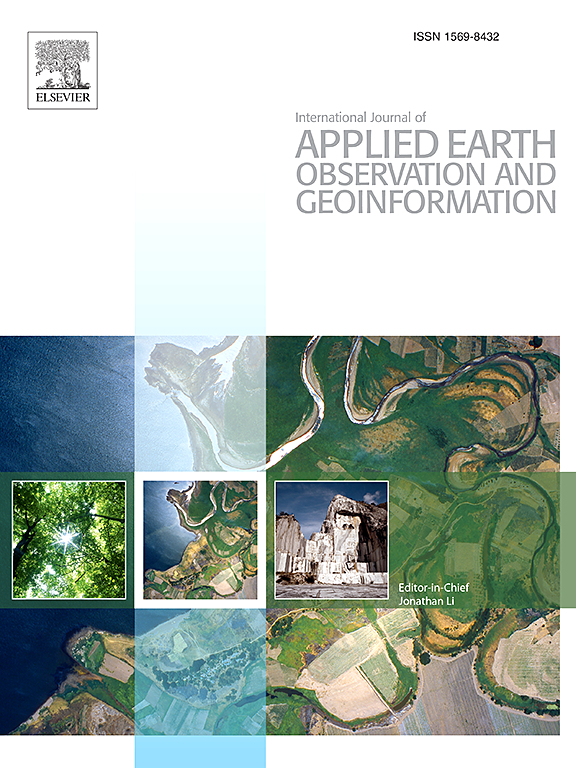Improving subpixel impervious surface estimation based on point of interest (POI) data
IF 7.6
Q1 REMOTE SENSING
International journal of applied earth observation and geoinformation : ITC journal
Pub Date : 2025-04-18
DOI:10.1016/j.jag.2025.104538
引用次数: 0
Abstract
Accurate estimation of impervious surface area (ISA) at the subpixel level is essential for understanding urbanization and its environmental impacts. In recent years, point-of-interest (POI) data has demonstrated unique value for urban studies. However, its potential for improving subpixel ISA estimation has yet to be fully realized. This research seeks to overcome the challenges of fusing POI data with remote sensing imagery and improve subpixel ISA estimation. To form an integrated sample dataset for subpixel ISA estimation, POI data were processed using kernel density analysis and transformed into continuous raster layers compatible with remote sensing imageries. The proposed method was tested in two study areas with distinctly different urban land patterns: Shenzhen, China, and Chicago, USA. Two widely used machine learning models, Classification and Regression Tree (CART) and Convolutional Neural Network (CNN), were developed based on the integrated sample dataset. The results show POI data significantly improved both models. Incorporating POI data reduced MAE by 52.75% for CART and 56.68% for CNN, and RMSE by 45.39% and 48.54%, respectively, compared to models without POI data. The fully trained POI-integrated CNN achieved the highest accuracy (MAE: 2.95, RMSE: 5.12, R2: 0.99). By achieving accurate subpixel ISA estimation with minimal additional procedures, the proposed method is expected to offer an objective and repeatable approach, providing reliable basic data for urban environmental research and planning.

基于兴趣点(POI)数据的亚像素不透水面估计改进
准确估算亚像元水平的不透水面面积(ISA)对于理解城市化及其对环境的影响至关重要。近年来,兴趣点(POI)数据在城市研究中显示出独特的价值。然而,它在改进亚像素ISA估计方面的潜力尚未完全实现。本研究旨在克服POI数据与遥感图像融合的挑战,改进亚像素ISA估计。为了形成亚像素ISA估计的完整样本数据集,对POI数据进行核密度分析,并将其转换为与遥感图像兼容的连续光栅层。该方法在中国深圳和美国芝加哥这两个城市土地格局截然不同的研究区域进行了测试。基于集成的样本数据集,开发了两种广泛使用的机器学习模型,分类与回归树(CART)和卷积神经网络(CNN)。结果表明,POI数据显著改善了这两种模型。与不含POI数据的模型相比,纳入POI数据的CART的MAE降低了52.75%,CNN的MAE降低了56.68%,RMSE分别降低了45.39%和48.54%。完全训练的poi集成CNN获得了最高的准确率(MAE: 2.95, RMSE: 5.12, R2: 0.99)。该方法以最少的额外程序实现精确的亚像素ISA估计,有望提供一种客观和可重复的方法,为城市环境研究和规划提供可靠的基础数据。
本文章由计算机程序翻译,如有差异,请以英文原文为准。
求助全文
约1分钟内获得全文
求助全文
来源期刊

International journal of applied earth observation and geoinformation : ITC journal
Global and Planetary Change, Management, Monitoring, Policy and Law, Earth-Surface Processes, Computers in Earth Sciences
CiteScore
12.00
自引率
0.00%
发文量
0
审稿时长
77 days
期刊介绍:
The International Journal of Applied Earth Observation and Geoinformation publishes original papers that utilize earth observation data for natural resource and environmental inventory and management. These data primarily originate from remote sensing platforms, including satellites and aircraft, supplemented by surface and subsurface measurements. Addressing natural resources such as forests, agricultural land, soils, and water, as well as environmental concerns like biodiversity, land degradation, and hazards, the journal explores conceptual and data-driven approaches. It covers geoinformation themes like capturing, databasing, visualization, interpretation, data quality, and spatial uncertainty.
 求助内容:
求助内容: 应助结果提醒方式:
应助结果提醒方式:


